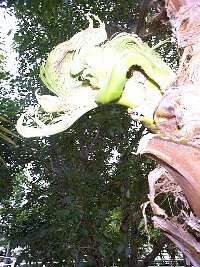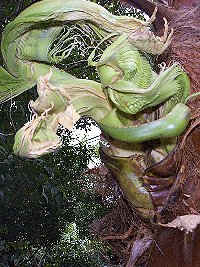

![]()
Palm "shortening" and regrowth of damaged palms
This "story" represents a compilation of e-mail messages sent to the International Palm Society e-mail list and to the webmaster personally. Messages are reprinted here with permission from the individual senders. The first message, which initiated a series of related stories by other members of the e-mail list, was titled "Strange story" and was posted by Martin Sloos of the Netherlands. A slightly edited version of this message is as follows:
I've heard a very strange story about reducing palms in their height. Here it is: when you want to reduce the height of a palm you can saw the trunk right through and put the it on a flat wet floor. The tubes in the trunk will deliver water by the growing strength of the crown. The palm will make new roots and will grow further. The best palm for this is Sabal palmetto. I know one of our hortussen in the Netherlands had a very old Brahea armata that was growing too high for their greenhouse. They tried this without a good result. (The tree was about 80 years old). Another Brahea (8 meters high) I have saved for this experiment and is now happy growing in a greenhouse of a friend of mine. I want to ask you, did anyone of you hear of such a story, and, if so what were the results.Also, in the wholesale nursery of a friend of mine here in the Netherlands, a Washingtonia is showing a second growing point, which only developed in the last two weeks. I know the palm had a hard time after it was imported from abroad; we thought it wasn't recovering from it's trip. I will keep you informed of further developments.
Photos taken mid-September, 1998.
The owner of the above palm sent a private e-mail to inform us about the progress of the strange growth on the Washingtonia. His message and photos are below:
A friend of my sent you some pictures of a Washingtonia robusta which shows a second growing point. I took some new pictures and here they are. We think that the normal growing point isn't growing anymore. Maybe you can put the new pictures up on the web page so everybody can see what's going on.
Best Regards, Jeroen van Ettinger (member I.P.S.)
Tropical Plantcenter
G. van der Arend Zn. B.V.
Lange Broekweg 17
 |
 |
|
|
Photos taken mid-October, 1998. |
|
![]()
Henry Donselman, a palm specialist, responded with another strange palm story:
A (late) friend of mine, Dr. Parthenasarthy in India airlayered an 80-foot coconut palm by building a wooden box structure around the trunk 60 feet in the air and putting peat moss, etc. in the box. When a massive number of roots developed, he cut off the top and lowered the palm in the ground, resulting in a shorter palm and increasing its life. This does not multiply the palm, only shows that the trunk has the potential to root out at any height. Also, this does not mean that palms can be planted with the rootball at any height. Never make a grade change! Its bad horticultural practice. . .
These photos of a date palm, Phoenix dactylifera, in Miami illustrate adventitious growth of roots similar to airlayering (described above). Date palms normally sucker, usually at the base; however, sometimes they form "branches" along the trunk. The formation of roots is the first step in the "branching" process.
![]()
And yet another strange palm story was sent in by George Stomatis of South Africa:
Here in South Africa Phoenix reclinata is as common as a weed (I think it should have the title weed) as it is native to our region. For this reason they are generally not highly esteemed by the general public or horticulturists, and they are often liberally felled for use in building retaining walls and other structures.In a caravan park some trunks of this species were chopped out from the riverside bush in the area. These were used on a slope in the park for erosion prevention. None of the crowns were removed, the leaves were simply sawed off. Several of the trunks, which where lying horizontally, actually sprouted at the old growth tips, the new growth pointing back upwards, along with strong root development. These are now rejuvinating into new plants. It seems like this palm is a bit like the Ti plant in its way of rejuvinating from horizontal canes. I would still rather propagate Ti plants though.
Eric Schmidt at Harry P. Leu Gardens in Orlando, FL, then added the following:
A few years ago we cut down a Sabal palmetto that had about 20 ft of clear trunk at Leu Gardens because it was competing with a large and old Camellia sasanqua. Once it was sawed down, we cut all the fronds off and left the trunk on the ground for a year before we finally hauled it off. It did'nt root but it did grow five healthy fronds during that year. Also, I have cut tall Chamaedorea elegans and C. metallica trunks below where aerial roots were forming and potted them up and they rooted and grew fine ( I didn't airlayer them just cut and potted up). We have also had a couple of Rhapidophyllum hystix grow stems several feet tall and then topple over because the lower portions die but the upper parts have roots. We sawed the dead portions off and replanted them and they regrew just fine.
Jerold Crawford, of Tampa, FL, added:
I have been amazed to see several Sabal palms in the Tampa area that were cut off several feet from the top of what I would consider the crown regrow from the truncated stump.
Neil Yorio of central Florida:
And to add another case of trunk/root re-growth, I know of a Central Florida Palm and Cycad Society member who successfully air-layered a Phoenix roebellinii after the trunk was damaged from a hard freeze. It is now thriving.John Kennedy of Fort Pierce/Vero Beach, Florida:
In the Fort Pierce, Florida, area road crews cleaning out a swale along a state road cut, almost to the ground, Sabal palmettos that were at least 15 feet high. About 20 palms were cut in a quarter-mile stretch; within several months, at least half began to show an emerging bud. All were dead eventually but I suspect a herbicide was used. This happened about five years ago on a road I frequently travel.
Arvydas Vaisnys in Miami, FL:
It has been about five years since an animal broke off the top of a Chamaedorea glaucifolia (right). I left the stem in the ground and it still looks green and fresh as ever. There has been no regrowth at all, the stem just sits there. Can the palm be considered alive? Who knows. The same thing happened to a C. elegans last year. Its stem is also still looking good as ever. Think about it. You never have to trim these palms, never dispose of dead leaves, etc.
![]()
| PACSOF Home Page | |||
| Virtual
Palm Encyclopedia Site Map Powered by FreeFind. |
|||
This site is copyrighted © 1998, 1999, 2000, Palm & Cycad Societies of
Florida (PACSOF)
For questions or comments, e-mail the webmaster.
Internet hosting provided by Zone 10,
Inc.